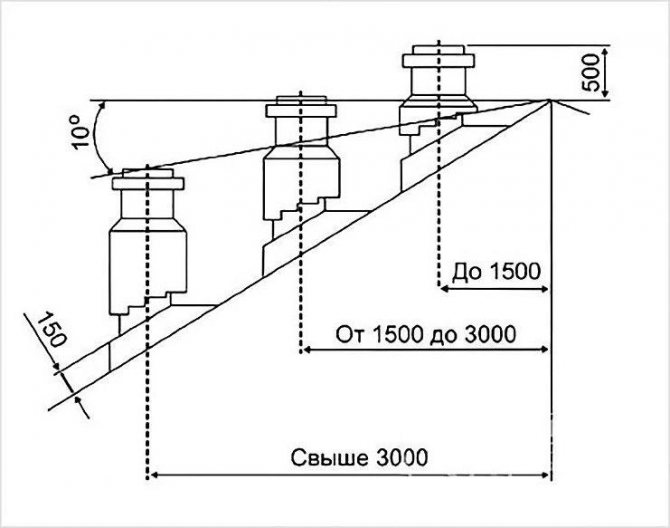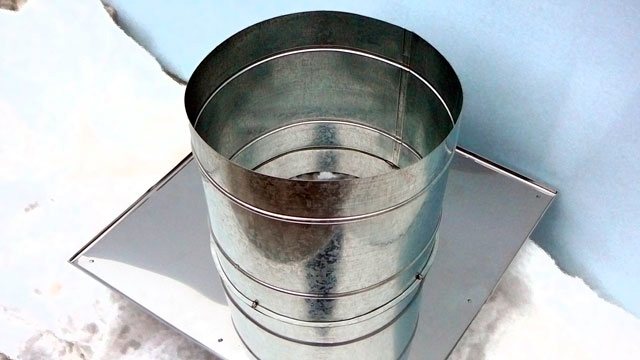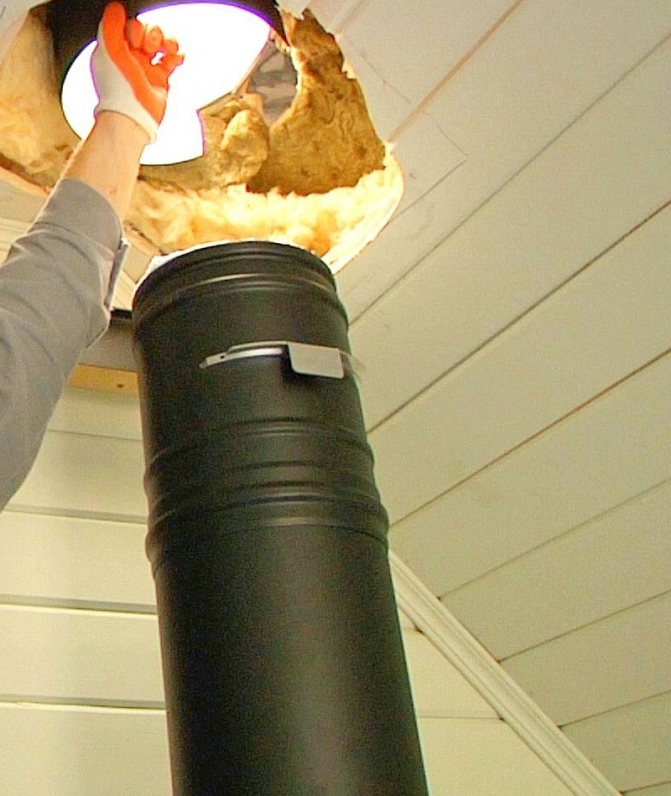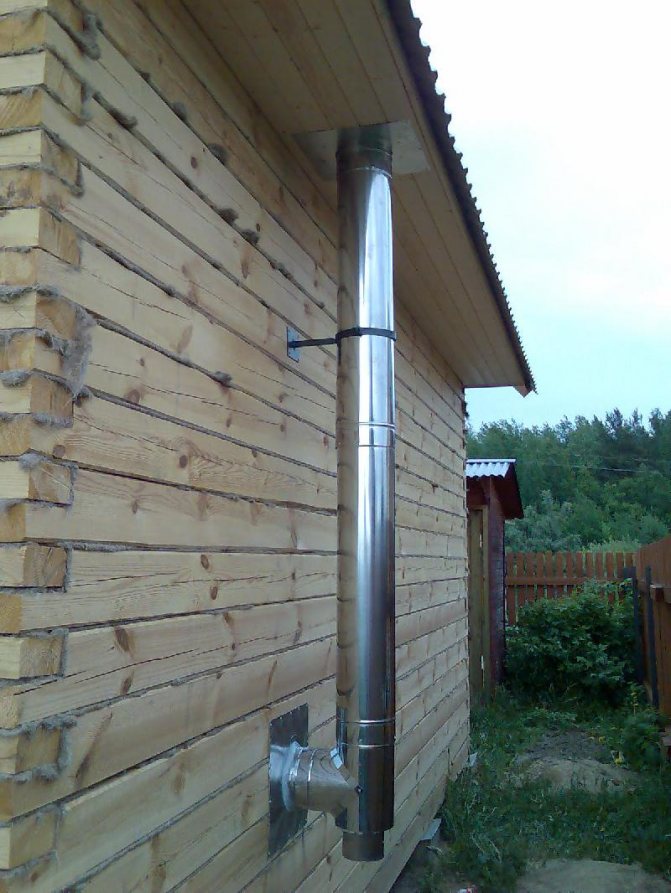Calculation of a chimney for a potbelly stove
After the stove is installed and ready for operation, it is necessary to install a chimney that can function correctly, keep the heat in the room and at the same time prevent combustion waste from entering the air of the room where the stove is installed. To do this, you need to correctly calculate the diameter of the pipe, its length and think over how it will remove smoke to fresh air.
In order for the heating system to have the highest efficiency, it is necessary that the pipe for the stove stove provides sufficient traction.
Expert opinion
Pavel Kruglov
Stove operator with 25 years of experience
The best is the ratio of the pipe diameter to the combustion chamber of 2.7 millimeters to 1 liter. For example, let's take a potbelly stove with a combustion chamber of 50 liters: 2.7 * 50 = 135 mm. It is this chimney diameter that will be optimal for the efficient operation of a 50 liter potbelly stove.
After the diameter of the chimney pipe has been determined, the length of the entire pipeline should be calculated. In these calculations, it is important to take into account not only the location of the stove, but also at what distance from the ridge is the chimney on the roof.

The pipe outlet should be located above the roof according to certain rules:
- The chimney is located from the roof ridge at a distance of up to 1500 millimeters, which means that the chimney outlet should be located at a height of 50 centimeters above the top of the ridge;
- With a distance of 150-300 centimeters to the visor, the outlet of the pipeline can be located at the same level with it;
- If the chimney is located near the edge of the roof, then its exit should be slightly lower than the ridge, or at the same level with it;
The second option for the exit of the pipe is through the wall, and not through the roof. In this case, the end of the chimney should be located just below the top of the roof ridge.


But the main long pipe will be the total distance from the outlet of the pipe to the stove itself - the calculations in each individual case will be different, it all depends on which floor, in which place of the room and at what height, the potbelly stove will be located.
Making a stove from a metal pipe
The process of creating this heating unit from a piece of large-diameter steel pipe for a potbelly stove is simple and consists of the following steps:
- A fragment of the required length is cut from the pipe. Using a welding machine, two holes are made, one of which will serve as a blower to provide air flow, and the second will be required to install a chimney for a stove stove.
- Next, a metal sheet is welded with pre-made holes in it, which have a small diameter - it is used as a grate. The element is placed so that it is between the combustion chamber and the blower.
- Then you need to build a cover that covers the combustion chamber. To do this, a sheet of metal is welded to the end of the pipe. If you equip an impromptu stove on the lid, then the stove can be used for cooking.
- Support legs are welded to the bottom of the heating unit.
- An ash pan is placed under the grate, which is a box for ash. It is desirable to equip it with a small metal door.
As a result of the work done, a stove from a pipe is obtained, which is capable of heating a small room in terms of area. But for the operation of the unit to be effective, a chimney is required. The process of arranging a smoke exhaust structure and manufacturing a pipe for a potbelly stove has a number of nuances.
We invite you to familiarize yourself with the passage of a metal pipe through the roof
Materials and their quantity
The list of materials required for the construction of a chimney differs depending on what kind of pipe structure it is decided to install. If the exit is to be carried out directly through the roof, then fewer corner elbows are required.
A standard size chimney will require the following number of pipes:
- 1 knee 120 cm long, 10 cm in diameter;
- 2 knees 120 cm long, 16 cm in diameter;
- 3 butt knees 16 * 10 cm;
- Tee with a diameter of 16 cm and a plug to it;
- Fungus - 20 cm;
- Sealant.
In addition, for the construction of various structures of the chimney, other details may be needed: an anti-spill canopy, a through glass, thermal insulation materials.
Expert opinion
Pavel Kruglov
Stove operator with 25 years of experience
A huge role is played by what pipes for the chimney from the stove it was decided to purchase, since the number, size and types of elbows will determine which structure will be mounted. If it was decided that the smoke extraction system would be outside the room, then it would no longer be possible to install it inside the building, since then a different set of parts would be required.
Tools
You only need cutting tools: a grinder, a jigsaw, a knife. All work is carried out manually and does not require special devices.
Installation diagram
There are several types of chimneys, the most suitable type of construction is selected individually.


Installation methods
It is important to take into account the collection of condensate in the system, therefore it is necessary to have a plug, a condensate drain and a container for collecting condensate.
If the potbelly stove is installed through the wall from the pipeline located on the street, then it will be advisable to bring the chimney through the window so that you do not have to prepare a hole for the pipeline in the ceiling.
The outer part of the chimney is insulated with thermal insulation, covered with a protective material. A fungus is installed at the end of the pipe, which will protect the chimney from debris, rain, various small animals and foreign objects.
Floor preparation
The chimney for the stove is most often installed in such a way that it passes through the ceiling, therefore, before installing and fixing the pipeline structure, it is necessary to make a hole for it in the ceiling: using a jigsaw or other cutting tool, having a diameter suitable for the passage of a glass for elbows of the internal chimney.
Example of a hole for a chimney pipe




Pass-through glass
A through glass is installed in the hole before the chimney for the stove stove is assembled. The diameter of the glass should be selected according to the diameter of the inner pipe, although sometimes the joint is made before the chimney passes through the ceiling. It should be understood that it is important to firmly fix the glass - it serves as a latch. But besides it, the pipeline must be attached to the surface of the wall.


With improper installation, there may be such consequences.
If there are easily flammable materials, insulation or wooden parts in the ceiling, then they must be removed so that they do not come into contact with the passage glass.
After the pipe has been inserted, all this must be sealed with a refractory material, for example, a heat-resistant sealant or special refractory wool.
The following stages of work in the photo:


Sealing


Leading the pipe to the roof


Roof work
At the last stage, you need to put a deflector on the pipe.
Tips for work
- The pipes used in the structure are located exclusively in an upright position; it is best to use special brackets to fix them, with dimensions corresponding to the elbows of the system.In order to save money, you can make brackets yourself using a metal corner.
- All connections must be treated with a sealant so that there are no holes left through which smoke can escape into the air of the room. There is a large selection of sealants on the market that are suitable for sealing pipe joints for smoke escaping:
- High temperature sealants;
- Heat resistant sealants;
- Heat resistant sealants;
- Heat resistant sealants;
High temperature and heat resistant sealants are used to seal places that reach temperatures of 350 degrees Celsius. Since the chimney for a stove stove heats up to higher temperatures, these types of sealants are suitable only for parts outside the pipeline system.
Heat-resistant and heat-resistant polymers can withstand enormous temperatures, up to 1500 degrees Celsius - they are the most suitable choice for a stove-stove chimney.
Connecting the chimney to the stove
The chimney coming out of the potbelly stove, called the internal one, is connected to the street, external pipeline, in the attic or in the under-roof part of the roof. The beginning of the internal chimney is a section coming out of the stove pipe, which is joined by a knee to the ceiling.
When installing an internal chimney, it is important to correctly connect the pipe to the stovepipe branch pipe - since if this is done incorrectly, smoke may escape into the room air, which will make it impossible for the heating system to function properly.
Expert opinion
Pavel Kruglov
Stove operator with 25 years of experience
The chimney is connected to the stove with a heat-resistant sealant and a special clamp. It is important to make a completely sealed structure, since any gas breakthrough can lead to poisoning those inside the room.


Chimney connected to the stove
Choosing a place for a chimney
The first question arises of what to make a chimney for a stove. Usually, the material for the manufacture of a chimney for a stove stove is selected according to its purpose. For a portable stove, it makes no sense to equip brick structures, it is enough to take a metal or asbestos pipe. But it is better to consult with a specialist on how to properly make a chimney for a potbelly stove.
Before you start assembling the structure, it is better to take all the dimensions and make at least a sketch. Since the chimney for the stove is a suspended structure and it is advisable to think over all the turns and joints in advance. Particular attention should be paid to the places of passage through walls, ceilings and roofs, as well as to calculate the number and shape of bends, to determine the length of the chimney for the stove.
Today, in hardware stores, you can pick up a pipe and elbows of any diameter for assembling a chimney, the main thing is how to calculate a chimney for a stove, to correctly determine its diameter. In factory-made stoves, there is already a small section of the outlet pipe, so it is easy to choose the diameter of the chimney for the stove. We complete the components according to the design, since there are 3 types of chimney outlet:
- in the wall under the ceiling. The most optimal design. The chimney of a potbelly stove inside the room plays the role of a heating device and a minimum of contact with other surfaces. And after dismantling, you can simply put in a ventilation grill. Usually, the chimney outlet for the stove through the wall is done at a height of 20-25 cm from the ceiling;
- in the ceiling. Quite an expensive design, since it is necessary to pass the ceiling not to get into the rafter system. Next, draw the pipe, cutting through the roof so that subsequently no water flows through the pipe. In the case of a two-story building, a hole will be added between the floors. Carrying out all these works, it is necessary to take into account fire safety;
- in the wall at the level of the exit from the potbelly stove. The safest way to fire, since the entire chimney is outside. But it has a number of disadvantages, the main of which is the rapid cooling of the pipe.In this regard, cold air draws heat from the stove and subsequently from the room. That is, after the stove has burned out, it is necessary to shut off the chimney, so that the room cannot be cooled through it.
When arranging a chimney for a stove in a garage or workshop, the first method is often chosen as the most effective.
Should you brick the pipe?
A metal chimney for a potbelly stove does not require special protection from external influences, but due to the visual effect and possible contact with a hot pipe, enterprising owners often brick the pipeline.
Expert opinion
Pavel Kruglov
Stove operator with 25 years of experience
But the construction of a chimney by means of brickwork is prohibited - such structures are not suitable for this heating system, an exclusively galvanized pipe for a stove is suitable for this role, it will provide good traction, it is easy to clean and check for defects. Ease of installation and easy maintenance are the main advantages of this hood.
Care and cleaning
The overall quality of work and the efficiency of the heating system directly depends on the condition of the chimney, so you should periodically pay attention to systematic maintenance of it.
It is necessary to conduct a complete inspection of the pipeline annually for cracks, burnouts, rust and other defects that can lead to unpleasant consequences. During the inspection, you should simultaneously clean the entire structure of the chimney from soot - this can be done by burning aspen wood in the stove.
Chimney care
In order for the chimney structure, and therefore the heating unit, to work properly, they should be looked after:
- At least once a year, the pipe for a stove in a garage, greenhouse, shed or living room should be checked for cracks, rust and burnouts.
- The chimney should be cleaned annually with special chemicals that must be burned in the firebox together with solid fuel. You can put a couple of aspen logs in the oven, which give a very high temperature during the combustion process. As a result, the soot is burned in the chimney.
- Use a mechanical method using a ruff, weights, etc. it will not work, since the design of the smoke exhaust of the stove is not durable.
We offer you to familiarize yourself with Is it possible to wash the body with tar soap
So that the stove-stove always has good draft, and there is no smoke in the room, it is imperative to carry out preventive measures that will help keep the chimney in order.
Any chimney requires periodic maintenance:
- In order for the pipe to be clean of soot deposits, it is necessary to periodically add chemical agents specially designed to loosen carbon deposits to the firewood being burned. For the same purposes, aspen firewood is also used, which helps to clean the inner walls. To clean the pipe with their help, only aspen firewood is used for preventive heating. It is advisable that they do not burn out quickly, but smolder for the maximum possible time in the firebox. To create such conditions, traction is artificially reduced by closing the blower after the firewood is well heated.
- Mechanical cleaning of the pipe from carbon deposits and rust is carried out annually. To do this, you can use a special cleaning brush with a load.
- After each cleaning, it is imperative to revise the surface by carefully lowering the included light bulb into the chimney. This is necessary in order to detect burnouts or cracks in time.
The process of installing a chimney from ready-made segments is quite simple, and it is quite possible to cope with it yourself. If there is a desire to make parts of the pipe on your own, then it is better to abandon this immediately, especially in the absence of experience in such work.
Since any chimney must be of the highest reliability, and all segments, when docked, must ideally match each other to seal them, it is recommended to install parts made exclusively at a professional level. It must be remembered that the ingress of carbon monoxide into the room from poorly sealed seams or burnt holes is, without exaggeration, a mortal danger.
Despite the seeming simplicity and unpretentiousness of the design, the chimney for the stove will need periodic attention. First of all, this should be manifested in the regular inspection of pipes for the appearance of rust, traces of burnout or cracks.
The presence of any of these defects should be a signal for the immediate replacement of the damaged section of the chimney. Left unattended, it will sooner or later turn into a source of danger for the residents of the house. At best, smoke will seep through the cracks; at worst, a burnt-out pipeline can simply collapse.
It is equally important to take care of the inner surface of the chimney, on which soot and ash will invariably accumulate during operation. The presence of a thick layer of soot can have several negative consequences at once:
- Traction decreases.
- Normal smoke extraction is impaired.
- The chimney design becomes heavier.
You can remove the accumulated soot with the help of special chemical compounds that are applied to the wood. Their components are completely harmless to human health, but for soot they are a truly formidable weapon.
Ordinary aspen firewood has almost the same effect. It is desirable that the aspen smolders little by little, and does not burn out quickly.
In structures equipped with additional elements, it will be enough just to cover the blower.
But traditional methods of cleaning (metal brush, core, ruff, high temperatures) will not work here, since thin iron may simply not be able to withstand.
Output
Installation of an exhaust pipe for a stove is not a complicated process and can be carried out independently, without the involvement of specialists. The main thing is to comply with fire safety rules, do not allow the chimney to come into contact with easily flammable materials and monitor the tightness of the structure.
With a responsible approach to the installation of the stove and the installation of the chimney, as well as correct operation, no problems will arise when using the heating system. If the installation of the entire system is incorrect, then like a boiler or fireplace, a stove can cause a fire.






















